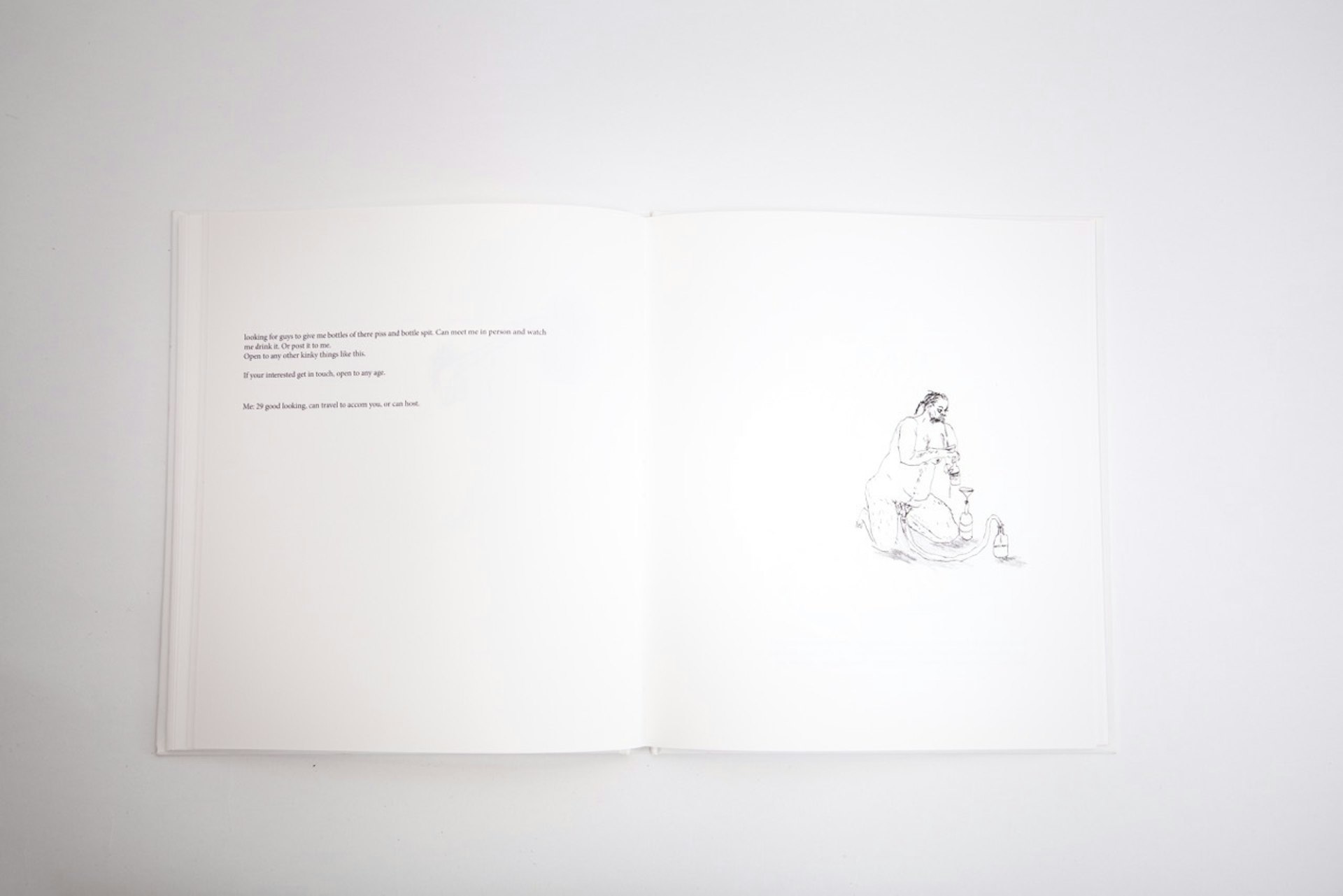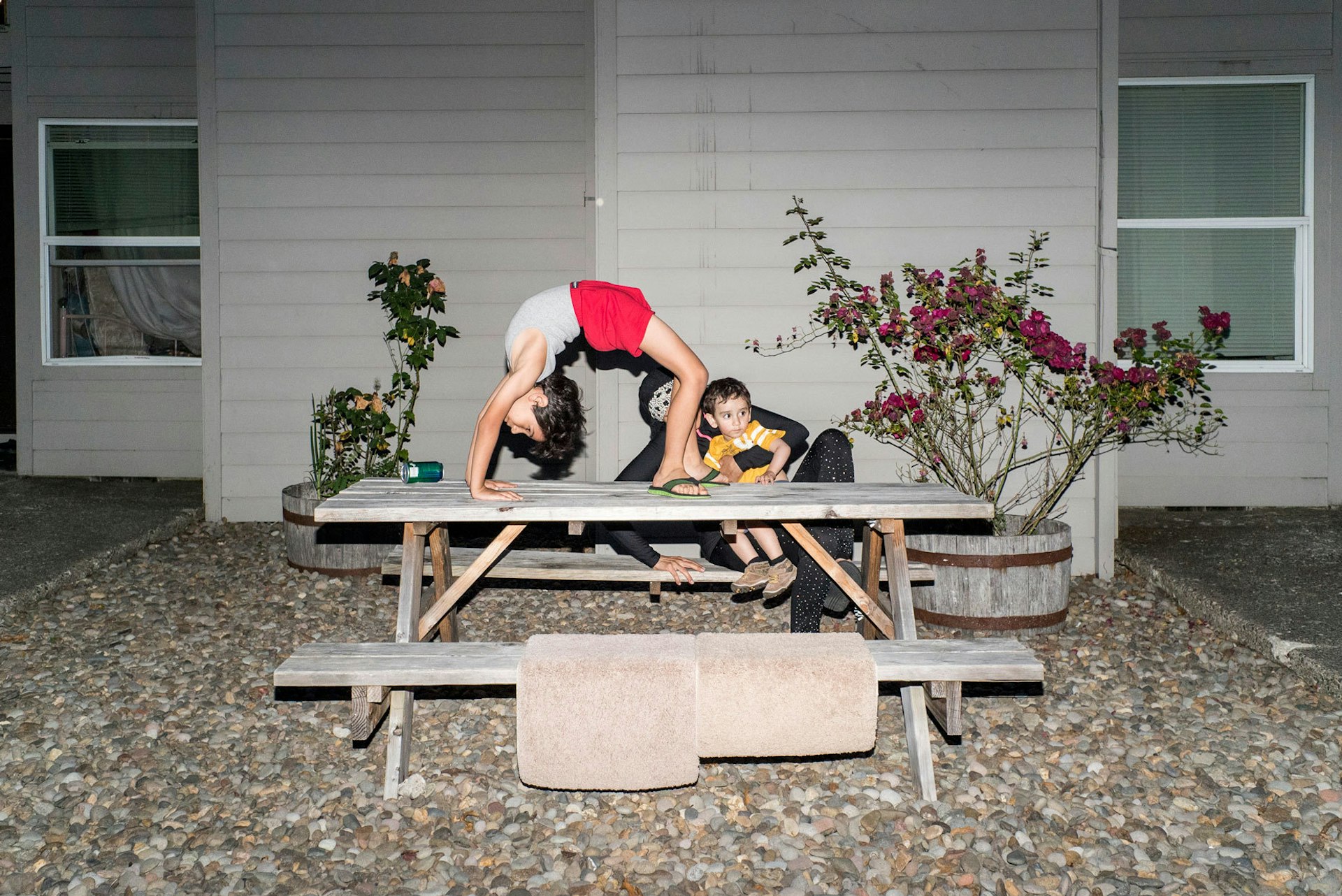
A photographer returns from war to make sense of home
- Text by Cian Traynor
- Photography by Peter van Agtmael
Peter van Agtmael was only beginning photography when 9/11 happened. He’d been studying history at Yale but it felt too detached from the things he cared about.
By the time American forces invaded Iraq, however, Peter had found his calling – a way to fuse his passion for history, war and photography into one pursuit.
In 2005, at the age of 24, he embedded himself with the US military in Iraq and went on to spend the next decade documenting the consequences of conflict.

New Orleans, Louisiana. 2012. A Second Line parade: a local African American tradition where brass bands — known as the first line — march in the streets and are joined by members of the public — called the second liners.
His new photo collection Buzzing at the Sill takes that gaze a step further, mixing reportage and personal history to offer a unique portrait of a country rife with division, violence and trauma.
Sitting in a director’s chair in Huck’s 71a Gallery, Peter – who’s 35 and grew up in the suburbs of Washington D.C. – has a professorial quality about him. Wearing a metallic blue jacket, a patterned white shirt and jeans – complete with curly hair and scraggly beard – he gives the kind of well-considered answers that could only come from someone deeply committed to their work.
Looking back at this collection of images, can you see a foreshadowing of where we are now?
I think so. Being in conflict areas brought up a lot of questions for me about what it meant to be an American at this moment in history.
Those questions couldn’t be entirely answered by looking at wars, so around 2009 I started looking more deeply at society around issues of class, race and the imprint of militarism.
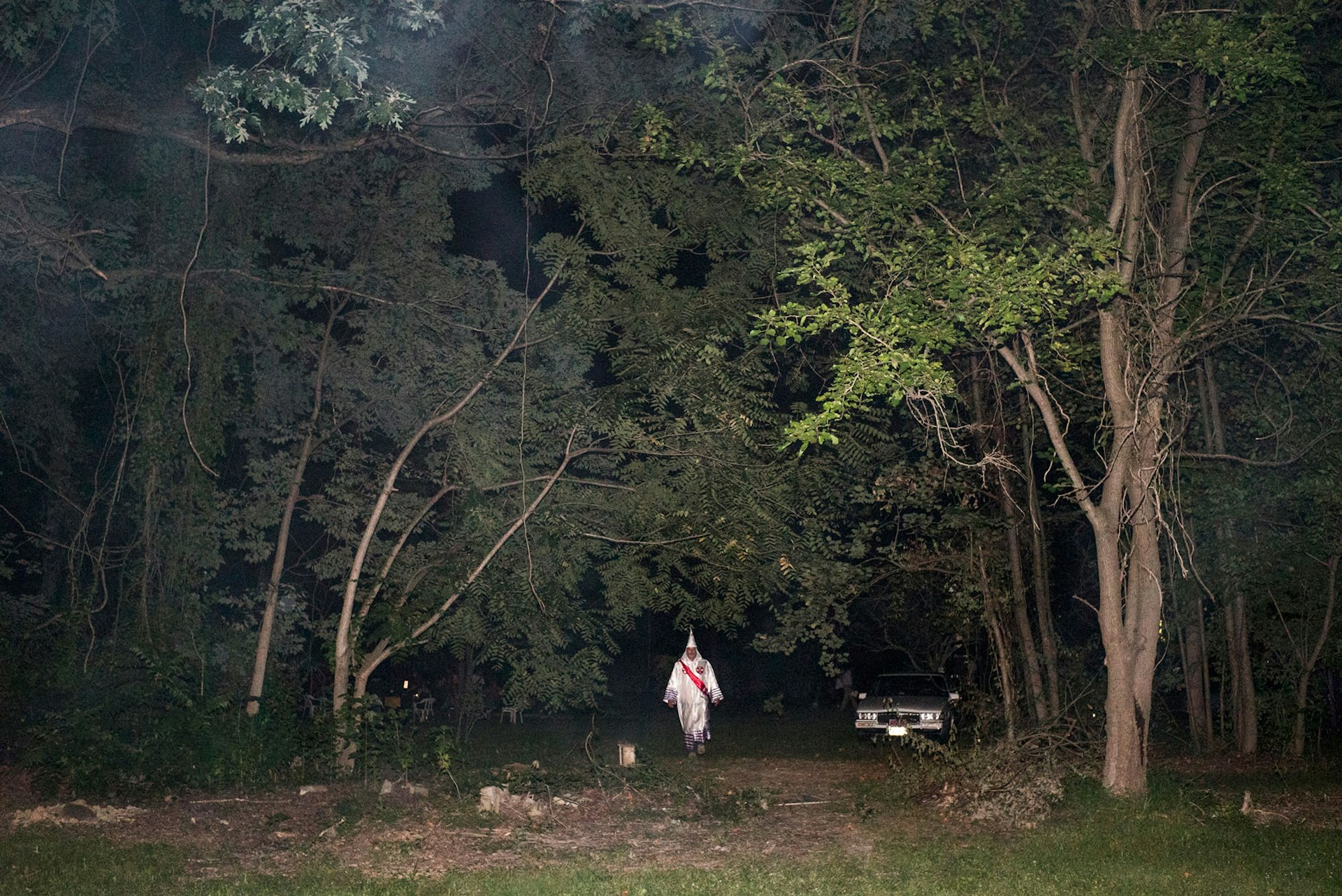
Maryland. 2015.
The KKK had boasted that dozens from their Klan chapter would attend the rally and cross burning, but there were only a few people when we showed up, including a British TV crew and a freelance photographer.
Focusing on all the little cracks and corners that most people aren’t exposed to made me aware of a deep malaise and desperation – one that could potentially be a powerful force if a sufficiently disruptive [political] candidate came to light.
That allowed for what we’re seeing now. What happens next is really unclear and frightening for a lot of people.
You’ve said that you can see the full spectrum of humanity at war. How did those experiences inform this project and what did you learn about America along the way?
When I went to conflict, it was as a journalist on my own at a really formative time in my life. It opened my eyes and isolated me simultaneously. The shadow of 9/11 and all that followed coloured my thinking. It probably created an identity that’s pretty wary of forces in society which inform people’s beliefs and create a political consciousness. Through the years, that has made me question propaganda in all its forms.
I’ve also learned that everyone has their own version of the truth and that’s something that has stuck with me. But I do wish people could better puncture the manipulation that’s a part of politics, the media, even pop culture and all these traditions of perceived greatness. It affects our ability to think honestly about what’s wrong with the place we’re a part of and what we can do to change it.

Pine Ridge, South Dakota. 2011.
Recently I spoke with a documentary filmmaker about absorbing second-hand trauma and how that often goes unacknowledged. Is that something you’ve dealt with?
Photography is this funny thing where you’re part of things and disconnected from them simultaneously. That’s a strange sensation. But you do need a thick skin to take in a lot of trauma second-hand – and sometimes it’s first-hand.
I’ve certainly lost people I’ve cared about over the years; I’ve nearly died on occasion. But it’s important to keep things in perspective: you’re privileged enough to be there and record those moments. Maybe it’s a personal history, maybe it’s something bigger. You shouldn’t be too precious about that.

Detroit, Michigan. 2012.
After dinner at Lyniece’s house.
At the same time, these things are painful. I’ve gone to therapy at a few different points. The flipside is thinking that you can continue absorbing that pain without confronting it yourself. In the past I was unwilling to do that.
Steadily I think I’ve gained a lot of self-awareness: when to keep pushing, when to hit the breaks a little and when to reverse out of there so I can have time to lead a lifestyle that’s emotionally sustainable.
Last year was the first time in 10 years that I didn’t go to conflict and cover war. It felt good and necessary to take that time. Now, slowly, certain stories are attracting me and I think I could ease into it again. But I’m mindful about keeping a centre of gravity.
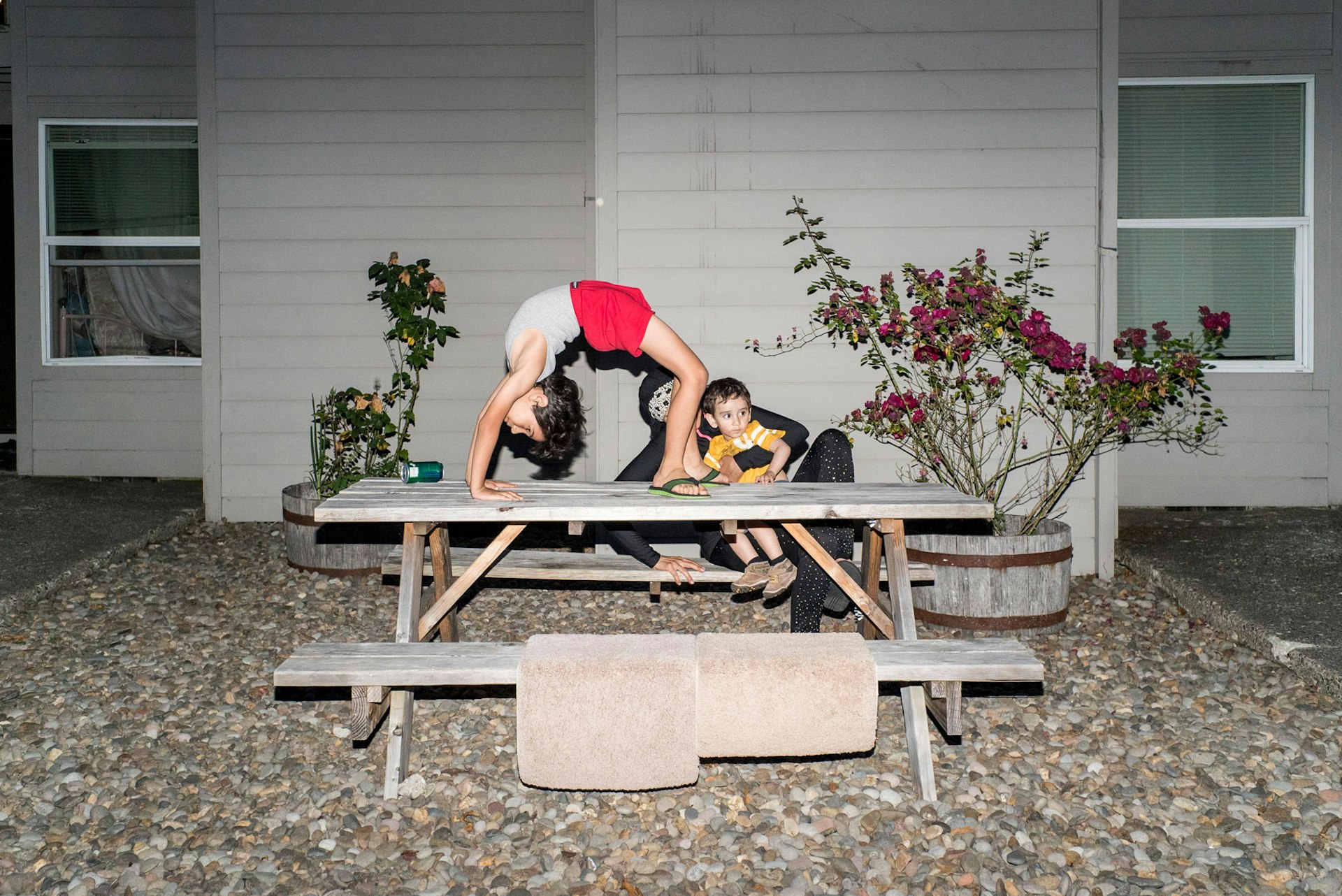
Portland, Oregon. 2015. Magnum Photos
Iraqi refugees in a low income housing community. The area is home to several thousand Iraqi refugees.
You were pretty determined to follow this path. Your aunt insisted that you shouldn’t go to war because she knew the impact it has, having been married to a cameraman who covered conflict. But you’ve said that from the moment you told your parents what you wanted to do, you never had a moment of doubt. Surely there must have been times, especially in danger, where you thought, ‘Oh, shit…’
Absolutely. But there’s a difference between moments of doubt and general confidence in one’s direction. I remember one moment covering the revolution in Egypt. It was during a weird time in my life; a relationship was falling apart for bad reasons. I was being reckless and stupidly got into this situation where I ended up getting beaten pretty badly by a mob.
I vividly remember the moment it started; I managed to run away and then got hit by a rock before these people converged on me and started fucking me up. I didn’t really feel the pain that much; I was almost outside of my body, just thinking the same thought over and over: ‘What a ridiculous way to die… You got yourself into this.’ I remember thinking about my parents and friends, getting angry with myself – all while getting the shit kicked out of me!
Some good samaritans saved my life and carried me out of there. My mind went back into body and I started feeling pain, fear and all those things. I had to spend time acknowledging the idiocy of some of my choices and realised there were lessons to be learned if I carried on covering these subjects.
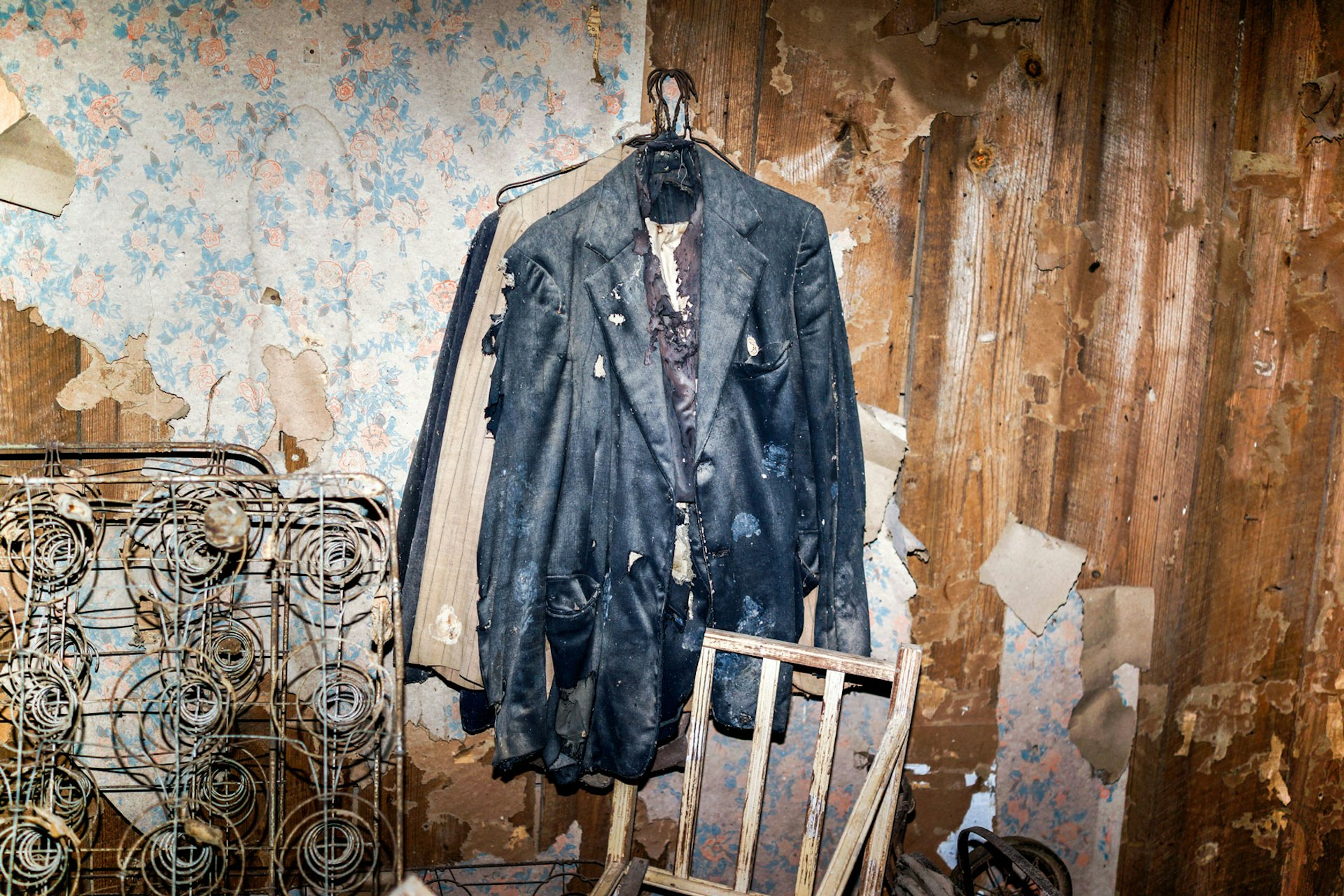
Hugo, Oklahoma. 2014.
The remnants of a Choctaw allotment after their forced expulsion to Oklahoma.
Was there something you wanted to prove to yourself initially?
Yes. Initially, it was about proving physical courage, testing myself against these edges of civilisation and human nature. That was important to me. That’s sort of dark and immature, and even though I’m slightly ashamed of that, it’s worth acknowledging.
Over time it’s more about the duty I feel to this work more than anything. And ambition, of course, at some point. It’s all these things intertwined. But the darkest part of it – neurotic insecurity and using war as a way of being a man or whatever – has long since faded away.
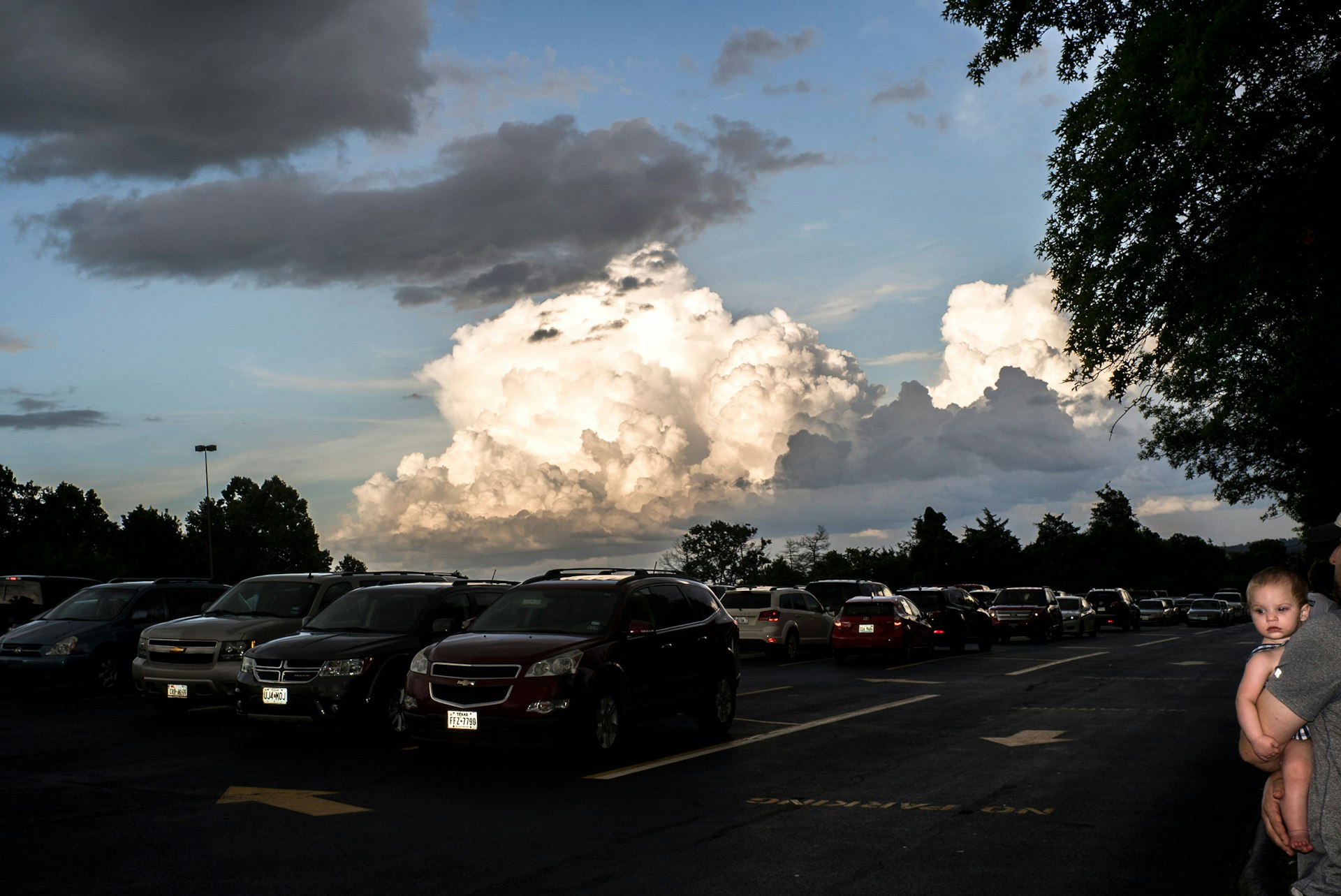
Branson, Missouri. 2015.
The parking lot of Dolly Parton’s Dixie Stampede.
There must be a process of hardening that happens over time. Does that clinical ability to spot something worth framing diminish your ability to be moved by something?
No, I think it has increased it. I’ve been doing this for a long time. It’s like learning to skateboard or something – the more you get accustomed to it, the more you refine the way you exist in that sphere and improve.
Photography is partly geometric and technical – but it’s also a very emotional process and I think I’m more open to that, generally speaking; that’s just a part of getting older. Most young men in their mid-twenties are self-absorbed.
Now I feel more sensitised to the world around me and the people I love, even the strangers I encounter along the way. It feels good; a healthy balance.
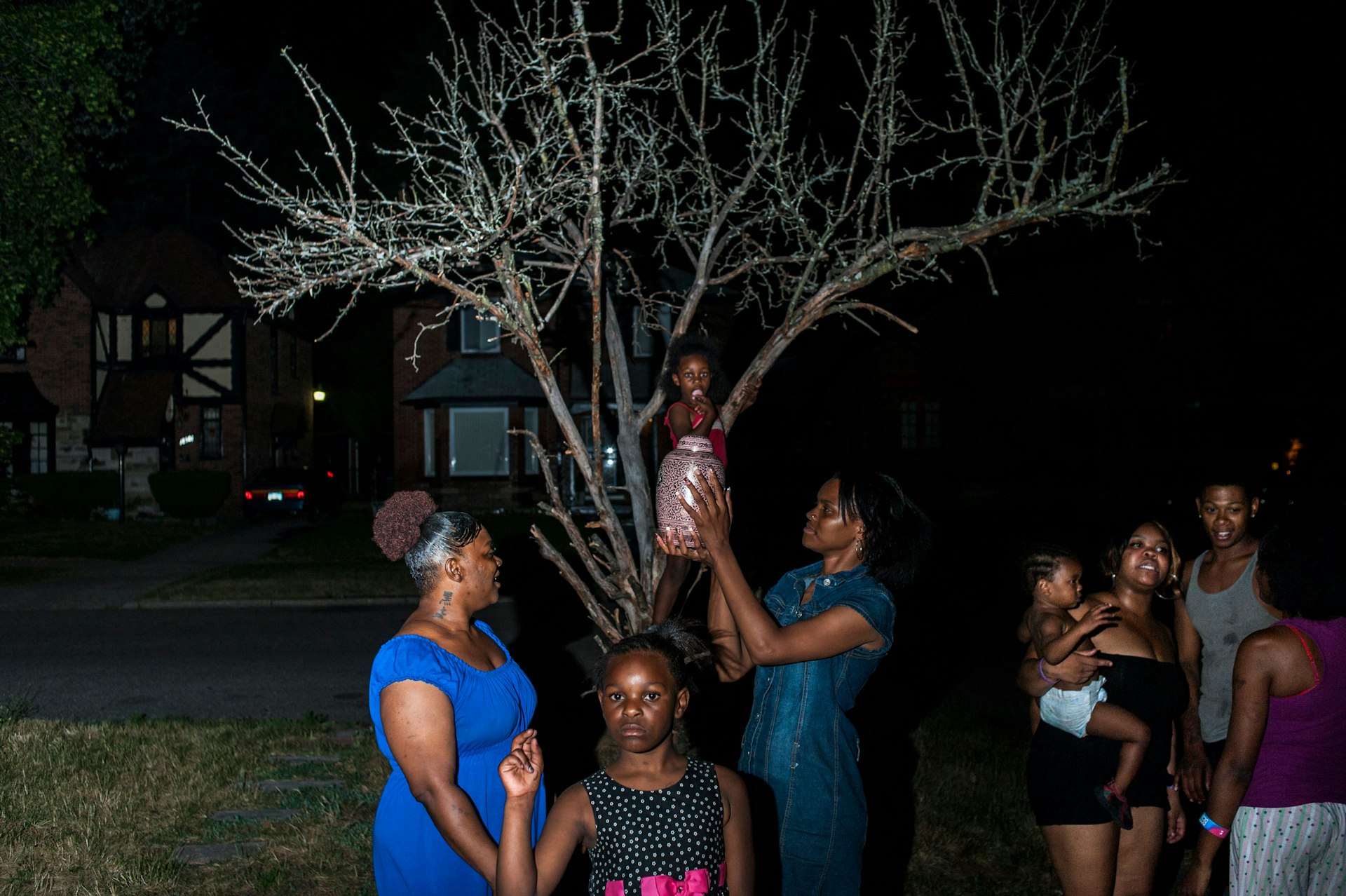
Detroit, Michigan. 2012.
Outside Lyniece Nelson’s house.
Would you ward someone against the perceived romance of heading off to war? I spoke to Lynsey Addario and she said that as noble as that duty is, it’s also selfish.
It’s very selfish. But there’s that classic line from [Michael Herr’s] Dispatches: “You can’t take the romance out of war.” Unfortunately it’s been so thoroughly romanticised within its depravity that it’s going to have an allure.
I would advise anyone going off to war to make damn sure that they don’t have a choice; that you need to do it so badly for your own complex personal reasons that you can’t ignore that impulse anymore. That’s what it felt like for me.
But there have been a lot of photographers I’ve met that were just there for the glory and way too inexperienced to be taking those kind of risks. If you’re going to make a choice that’s so serious and selfish, you need to be very sober and work up to it methodically so that when you make that leap, you are fully committed.
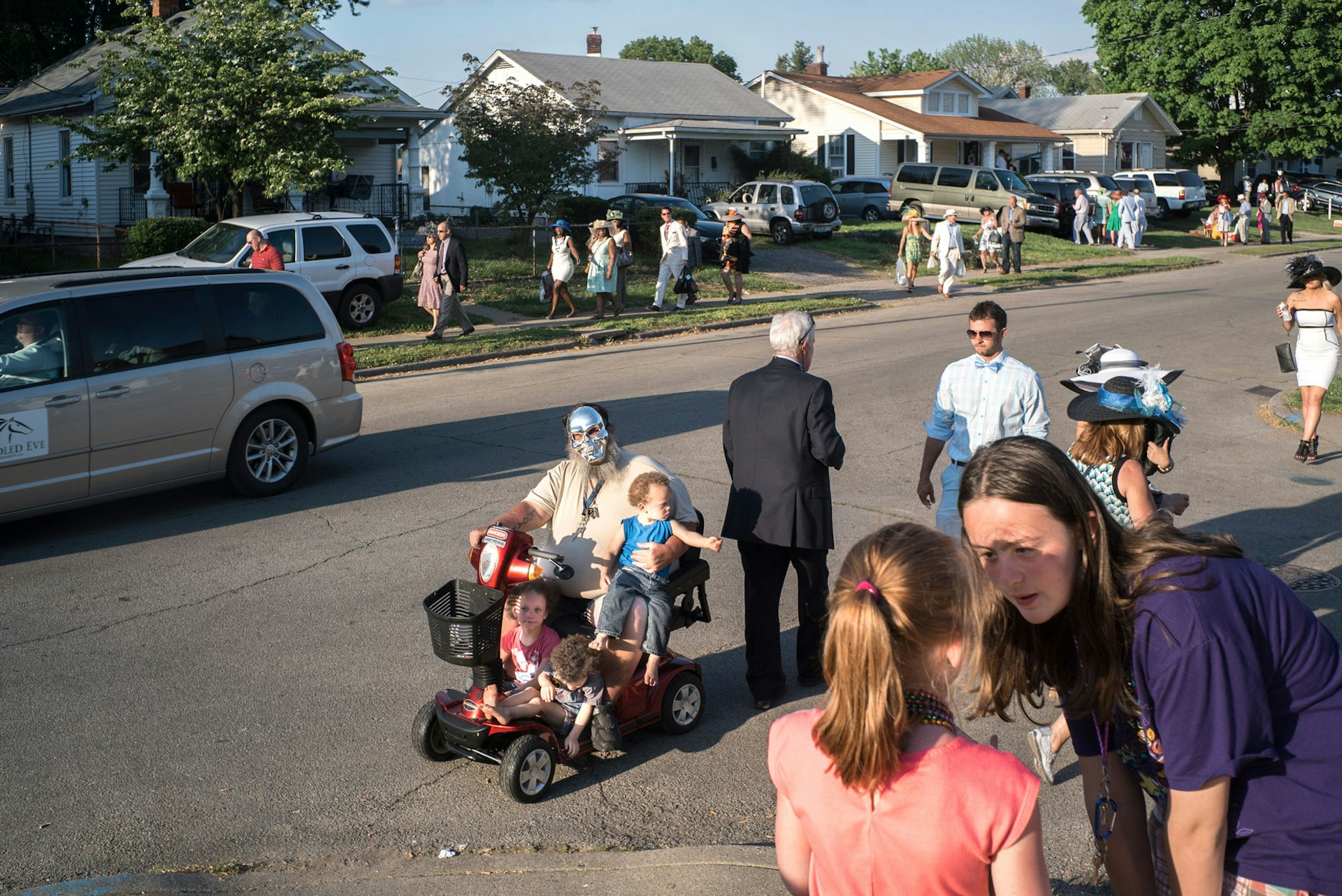
Louisville, Kentucky. 2015. Aftermath of the
Kentucky Derby.
What advice would you have for someone who’s just picking up a camera that they wouldn’t get in a class?
Ha! There are a few things. The first is: don’t try to jump on the same thing that everyone else is doing unless you feel deeply compelled and you know you have a good way of doing it.
Be inspired, but don’t mimic. You hear how, after every World Press Photo Awards, the next year draws all these copycat stories of whatever won the year before, which is a very insincere process.
Go slowly. You need to be developing as a person as well as a photographer; the two feed into each other and that takes time. It’s important to be single-minded but not to the exclusion of being a well-rounded person.
Beyond that, if you’re thinking about photojournalism, find a lot of other income sources besides editorial work or you’re not going to be able to make a living! [Laughs]

Des Moines, Iowa. 2010.
At the annual Iowa GOP Ronald Reagan dinner, Sarah Palin gave the keynote speech, which was seen as testing the waters for a possible presidential
run.
As a photographer, how do you pierce compassion fatigue?
It’s tough. I’m somewhat resigned at times that a lot of the work I do is going to reach a very self-selected group of people. It’s why I’m not working explicitly as an artist towards the gallery world.
This is a moment in history where you have to ask yourself whether whatever you’re working on is just sustaining a two-dimensional narrative. It may be based in fact but isn’t finding a way to cross these boundaries to the way other people think. I don’t really know how to cross that line and this is what scares me.
It feels like people have solidified their ideologies and they’re only looking to perpetuate them through the way they seek information. Ever since the election, I’ve started consuming a lot more conservative news and I’m struck by how different their daily narrative is from, say, the New York Times.
That grey area between the two that allows for sober and thoughtful work to have influence… I don’t know where that place is. I haven’t found it yet.
You’ve called the free press a cornerstone of democratic, civil societies and vital to historical narratives. Does that seem under threat now?
I don’t think the institutions of the free press are under threat, apart from verbally by the Trump administration, but the soul of it is… and what that means for society is frightening.
You would think, at least in the States, that people on both sides of the ideological and political spectrums have a lot of common interests. It seems harder to find that common ground.
I was just doing a story in Guantanamo Bay and I was sharing a house with an IT guy, a Trump voter.
We disagreed with one another but we were both struck at how this was one of the few opportunities we’d had in years to have a civil discourse with someone with a different ideology. And that’s a bit scary.
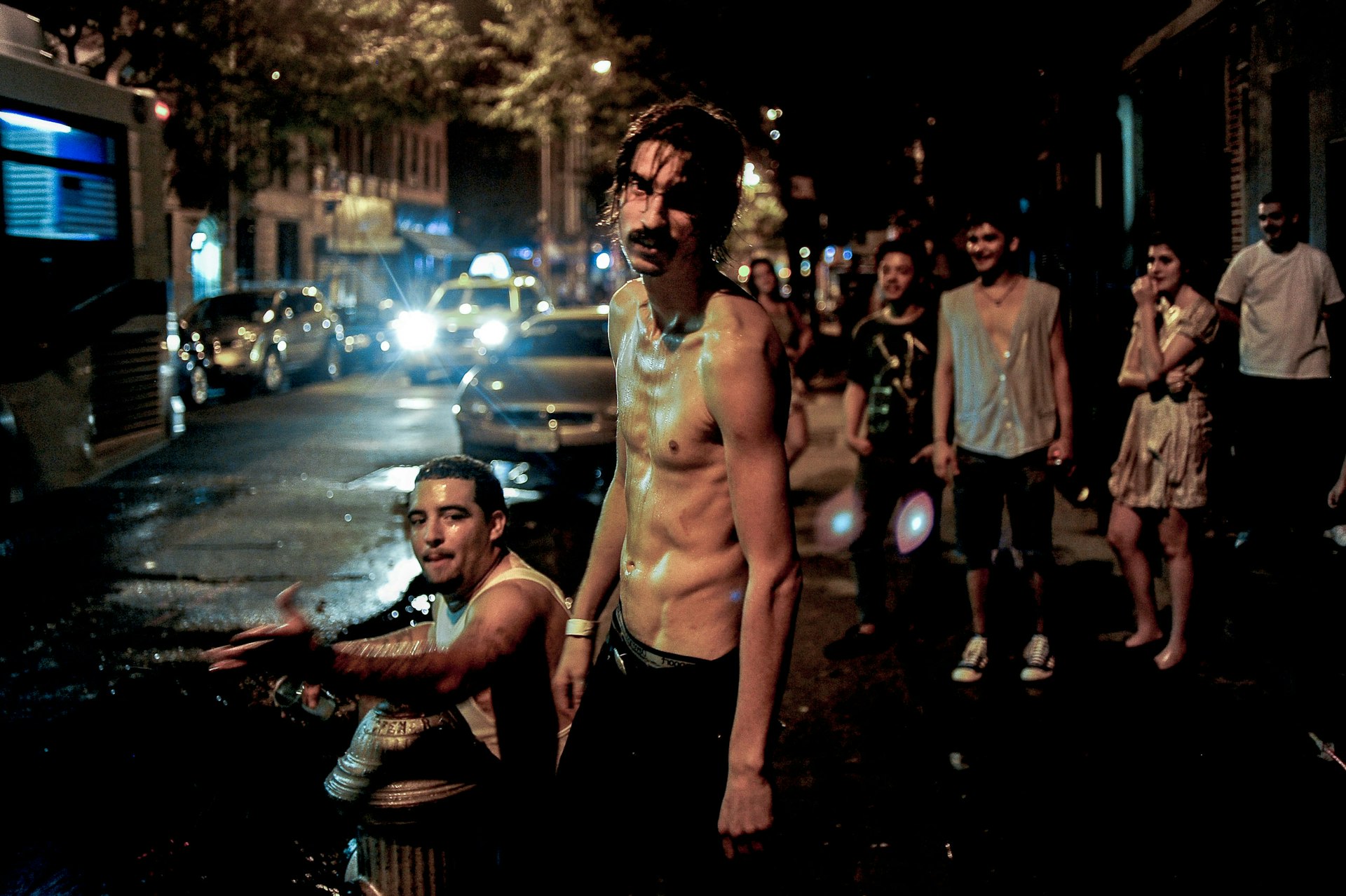
Brooklyn, New York. 2010.
The Fourth of July.
This image of a topless guy in Brooklyn: what does it represent to you?
In the book or in my life?
Well, I’d be curious to know the difference between the two…
In my life, it came at an interesting point. When you become part of Magnum, there are various tiers of membership. You start off as a nominee and once you get voted in, there’s a trial period of two years. Then you submit a portfolio and either become an associate for another two years before eventually becoming a member, or you’re given another year to keep developing your work.
That year, I submitted a portfolio where I wasn’t entirely being myself. I was kind of catering to what I thought Magnum wanted and it was unsuccessful.
That picture was the first one I took after that rejection. I realised I really needed to be myself and let the chips fall where they may. That was important to me.
And that’s just the kind of narrative that can distort whether or not it’s actually a good picture because it’s tied to an emotional moment that wouldn’t matter to anyone else.
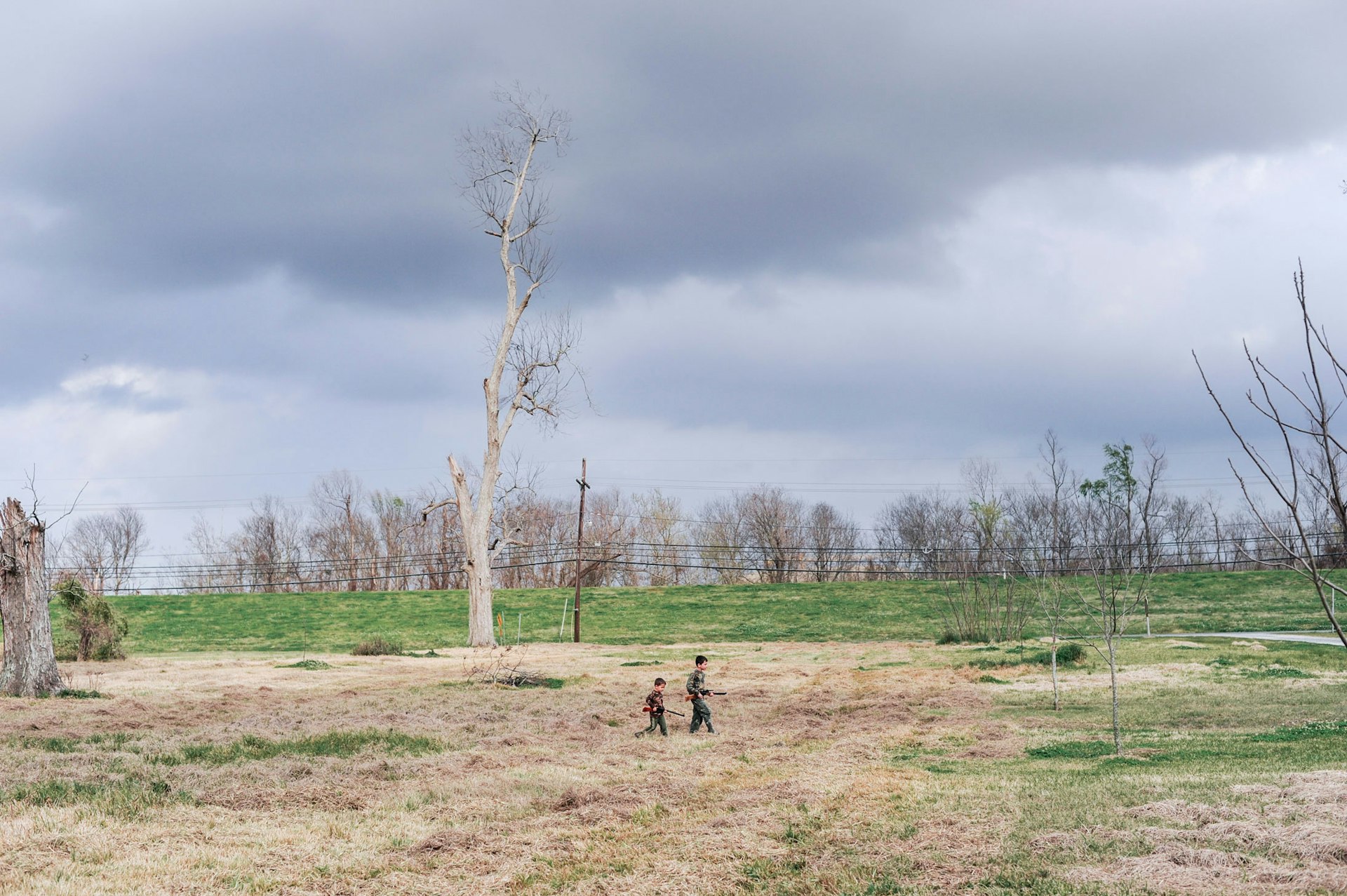
On the outskirts of New Orleans, Louisiana. 2009.
Hunting rabbits with BB guns.
On a photographic level, it doesn’t necessarily have some deep symbolism. The book is a series of fragmentary moments, some of which are tied to American history and my experiences at war, and some of which just exist independently of those things.
This picture exists independently. It was an individual I found powerful in that moment. And then it was over… but it remains a kind of beautiful thing to me.
Buzzing the Sill is published through Kehrer Verlag. Find out more about Peter van Agtmael at Magnum or follow him on Instagram.
Enjoyed this article? Like Huck on Facebook or follow us on Twitter.
